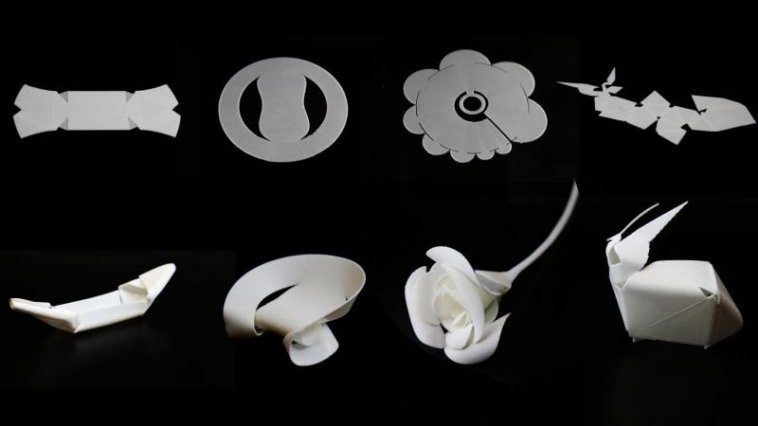
Researchers from Carnegie Mellon University are using a desktop FDM 3D printer, off-the-shelf filament and a design editor to create flat prints which self-fold into different shapes when heat is applied. This technique is called Thermorph.
In an effort to imbue objects with the ability to self-assemble, researchers from Carnegie Mellon University have developed a technique in which 3D printed thermoplastic composites fold themselves into predetermined shapes. With the simple application of heat the researchers’ flat 3D printed objects jump to life, folding along predetermined lines into the prescribed three dimensional object.
The research was conducted with the goal of opening the door to tangible real world products with accessible assembly processes. With the help of a heat gun or even the warmth of the sun, future furniture or even emergency shelters that are shipped flat could pop up and fold into their final shape.
The researchers argue that producing such self-folding materials with off-the-shelf filaments and an FDM 3D printer is both cheaper and quicker than creating solid 3D objects. Therefore, creating prototypes would be easier and could save companies a lot of money.
This certainly isn’t the first 4D, self-folding technique around. In fact, All3DP has covered many in the past. However, the researchers claim that what makes Thermorph special is its cost effectiveness.
“We wanted to see how self-assembly could be made more –democratic—accessible to many users,” Lining Yao, assistant professor in the Human-Computer Interaction Institute and director of the Morphing Matter Lab, said in a statement.
Thermorph Saves Money and Time
Why use FDM 3D printers? Firstly, they’re an inexpensive option. For many users, an issue arises with prints warping as they cool on the print bed.
The researchers used this phenomenon to their advantage, varying their print speeds to deposit combinations of thermoplastics and rubber-like materials that resist contracture. When the prints are placed in hot (but not too hot) water, they become soft and rubbery and begin to fold.
To ensure prints would fold in a particular way, the researchers used their own code, instead of the FDM printer’s open source software. Byoungkwon An, a research affiliate in HCII, explains:
“The software is based on new curve-folding theory representing banding motions of curved area… The software based on this theory can compile any arbitrary 3D mesh shape to an associated thermoplastic sheet in a few seconds without human intervention.”
The researchers designed and printed self-folding geometries with up to 70 faces to demonstrate the technique. The prints included self-curved geometric primitives and 4 self-curved applications. For example, the simplified Stanford Bunny, chairs and flowers.
Finally, the researchers add in their study abstract: “Compared to the standard 3D printing, our method saves up to 60% – 87% of the printing time for all shapes chosen.” To find out more, read their study published in ACM Digital Library.
Source: RDMag
Website: LINK


